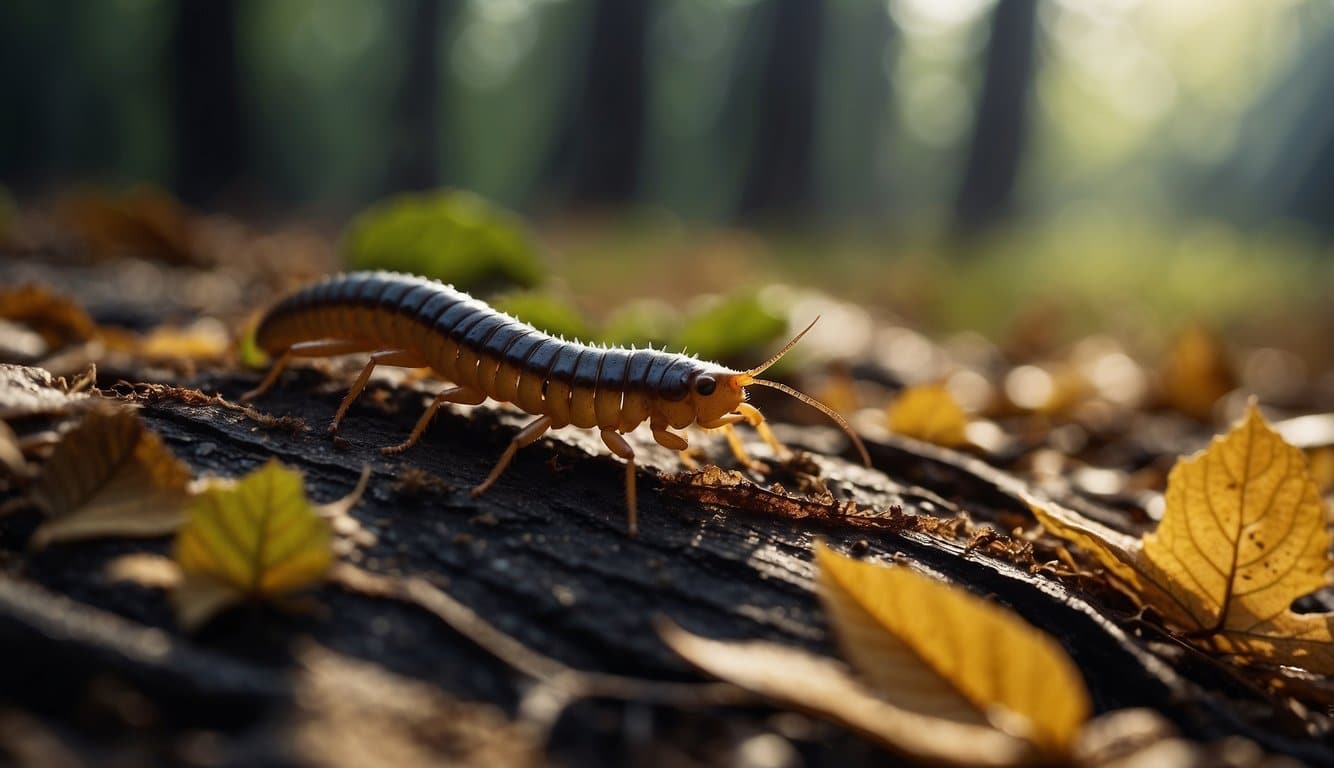Know Your Enemy: Centipede Identification
When you spot a many-legged critter scurrying across your floor, knowing exactly what you’re dealing with is key to choosing the right battle plan.
Arm yourself with knowledge to take the upper hand.
The House Centipede
- Scientific Name: Scutigera coleoptrata
- Body Length: 25-30 mm
- Legs: 15 pairs of long, slender legs radiating from the body
- Color: Yellowish-gray with three dark stripes running down the back
The house centipede is easily identifiable by its elongated body and swift movements.
This centipede prefers the cool, damp environment of your basement or bathroom and is often seen as a pest, but they’re predators to other unwanted insects.
The Garden Centipede
- Scientific Name: Commonly refers to various species in the order Geophilomorpha
- Body Length: Varies; some up to 60 mm
- Legs: Up to 177 pairs of short legs for some species
- Color: Typically brown to reddish-brown
Many centipede species, such as those in the garden, thrive in outdoor soil.
They’re crucial for the ecosystem, breaking down decaying matter and controlling other insect populations. Your garden variety centipede is more reclusive, only coming out at night to feed.
Arm Yourself: Natural Predators and Centipede Traps
To combat centipedes, you can harness the power of their natural enemies and strategic traps.
Let’s create a battle plan that includes recruiting the help of nifty natural predators and setting up effective traps around your home.
Recruit Spiders and Other Natural Hunters
- Spiders: These eight-legged creatures are allies in your quest. They prey on centipedes and help keep the population in check.
- Where to find them: Check in corners, under furniture, and other quiet places.
- Attract them: Keep areas clutter-free to invite spiders to settle in and start hunting.
- House centipede predators: Certain animals, such as toads and birds, naturally feed on centipedes.
- Cultivate a garden: Encourage these creatures to visit by providing a welcoming outdoor environment.
Set Up Sticky Traps
- Sticky traps are a simple yet effective tool for catching centipedes and other unwanted critters.Here’s how to use them:
- Identify hotspots: Place traps in areas where centipedes are frequently spotted.
- Check regularly: Monitor the traps and replace them as they fill up with pests.
- Trap placement tips:
- Near entry points: Position traps along baseboards, windows, and doors.
- Stay inconspicuous: Hidden areas, like beneath sinks and behind appliances, are prime trap locations.
Fortify Your Castle: Sealing Entry Points
To keep centipedes at bay, it’s crucial to stop them from entering your home in the first place.
Focus on sealing off any access points with precision and diligence.
Caulk Cracks and Crevices
- Inspect Your Home: Walk around the exterior of your house and identify any visible cracks in the foundation or gaps where utilities enter your home.
- Apply Caulk: Choose a suitable caulk for your home’s exterior surfaces and meticulously fill these gaps to cut off centipede traffic.
Repair Window and Door Screens
- Inspect Screens: Check all window and door screens for tears or holes that centipedes could use to crawl inside.
- DIY Repairs:
- For small holes, apply clear nail polish or a piece of adhesive screen patch.
- Larger damage may require a screen repair kit, which can efficiently restore barrier integrity.
Battle Tactics: Home Remedies and Repellents
Gear up for the skirmish against those sneaky centipedes with some tried-and-true home remedies and repellents!
Tackling this problem doesn’t have to involve chemical warfare. Instead, you can rely on natural substances and concoctions that these many-legged intruders detest.
Deploy Diatomaceous Earth
- What You Need: Food-grade diatomaceous earth
- How to Apply: Sprinkle a thin layer around baseboards, in corners, and other centipede hideouts
Diatomaceous earth is the ninja of the pest control world.
It’s a fine powder made from the fossilized remains of tiny, aquatic organisms called diatoms. The abrasive quality of diatomaceous earth damages the exoskeleton of centipedes upon contact, leading to dehydration.
Remember, food-grade is the way to go to keep it safe for your household.
Mix Your Own Natural Repellents
- Key Ingredients: Essential oils like peppermint, tea tree, or eucalyptus
- Simple Recipe: Combine 20 drops of essential oil with water in a spray bottle
- Application Strategy: Mist the mixture in areas where centipedes frequent, refreshing weekly
Creating your own natural repellents is like crafting a magical potion to ward off the creepy-crawlies.
Essential oils aren’t just for a pleasant aroma; they are a bane to centipedes’ existence.
Regular application of this natural deterrent will send centipedes packing. Keep the battle fun, refreshing your homemade concoction each time with a sense of victory!
Maintain the Perimeter: Ongoing Prevention Strategies
Securing your home against centipedes means reinforcing the outside to prevent these critters from making their way in.
Focus on moisture control and cleanliness to create an unwelcoming environment for them.
Keep Your Home Dry
- Eliminate Moisture: Centipedes thrive in moist environments, so it’s critical to keep your home as dry as possible.
- Repair leaking faucets or pipes.
- Use dehumidifiers in damp areas like basements or laundry rooms.
- Ensure good ventilation, especially in crawl spaces and attics.
- Outdoor Drainage: Properly maintain gutters and downspouts to channel water away from your home’s foundation.
- Clean gutters regularly to prevent water from spilling over.
- Extend downspouts to carry water at least 3-4 feet away from your home.
Regular Home Cleaning Regimen
- Declutter: Reducing clutter eliminates hiding spots for centipedes.
- Store items in plastic bins rather than cardboard boxes.
- Keep storage areas tidy and off the ground when possible.
- Vacuuming and Cleaning: Regular housekeeping can greatly reduce centipede populations.
- Vacuum floors, especially in corners and under furniture, weekly.
- Wipe down surfaces and clean spills promptly to avoid attracting other insects, which centipedes feed on.
Frequently Asked Questions
Centipedes can be uninvited guests in your home, but there are various strategies to curb their intrusion. Read on to discover natural remedies, preventive measures, and immediate solutions to keep these many-legged critters at bay.
What natural remedies can keep house centipedes at bay?
You can repel house centipedes naturally with essential oils like cedar and peppermint.
Mixing these oils with water and spraying them around your home can help deter these pests. Explore more on using essential oils to repel centipedes.
Can a certain type of salt effectively eliminate centipedes?
Yes, diatomaceous earth, which is a type of salt, can be effective.
Sprinkling it around potential entry points can dehydrate and kill centipedes that come into contact with it.
What are the best ways to prevent centipedes in the home environment?
Keep your home environment unfriendly to centipedes by:
- Sealing cracks and gaps where they might enter.
- Reducing moisture by using dehumidifiers or fixing leaks.
- Keeping areas like basements and closets dry and clutter-free.
For specific strategies, Bob Vila offers clear guidance on prevention.
Are there any immediate solutions to eradicate centipedes on contact?
Store-bought pesticides can work instantly on centipedes.
If you spot them, you can spray directly for a quick kill. Remember to use these products cautiously and according to their labels.
What could be the cause of a sudden centipede infestation in my home?
Sudden infestations may be due to increased dampness or the presence of other small insects that centipedes feed on. Checking for and addressing leaks can help you tackle the root of the problem.
Why might it be a bad idea to crush a centipede found indoors?
Crushing a centipede can lead to the release of more eggs if it’s a female.
This might ironically lead to more centipedes. Consider catching and releasing it outside or using non-physical methods to control them.
Last update on 2025-06-06 / Affiliate links / Images from Amazon Product Advertising API





